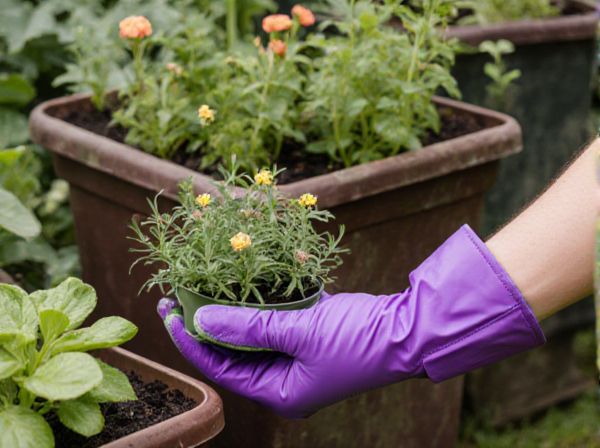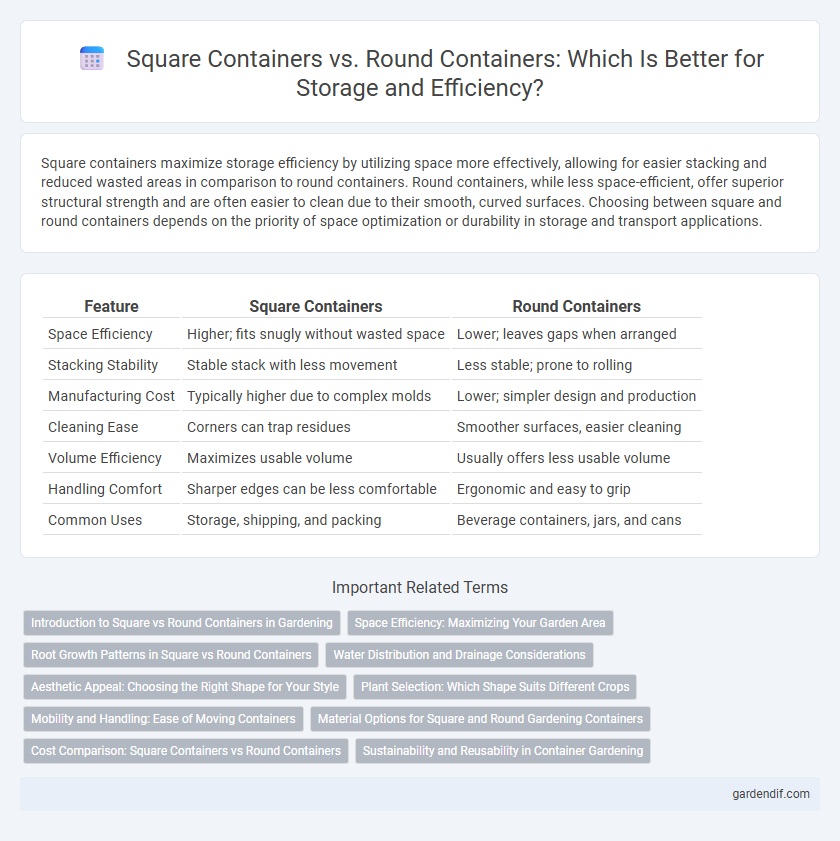
Square containers vs round containers Illustration
Square containers maximize storage efficiency by utilizing space more effectively, allowing for easier stacking and reduced wasted areas in comparison to round containers. Round containers, while less space-efficient, offer superior structural strength and are often easier to clean due to their smooth, curved surfaces. Choosing between square and round containers depends on the priority of space optimization or durability in storage and transport applications.
Table of Comparison
| Feature | Square Containers | Round Containers |
|---|---|---|
| Space Efficiency | Higher; fits snugly without wasted space | Lower; leaves gaps when arranged |
| Stacking Stability | Stable stack with less movement | Less stable; prone to rolling |
| Manufacturing Cost | Typically higher due to complex molds | Lower; simpler design and production |
| Cleaning Ease | Corners can trap residues | Smoother surfaces, easier cleaning |
| Volume Efficiency | Maximizes usable volume | Usually offers less usable volume |
| Handling Comfort | Sharper edges can be less comfortable | Ergonomic and easy to grip |
| Common Uses | Storage, shipping, and packing | Beverage containers, jars, and cans |
Introduction to Square vs Round Containers in Gardening
Square containers maximize space efficiency by fitting neatly side-by-side, allowing gardeners to utilize growing areas more effectively compared to round containers, which can waste space due to their curved edges. Square containers also often provide better root development by preventing circling roots that round containers encourage. Round containers facilitate easier moisture distribution and drainage, but their shape limits planting density in small garden setups.
Space Efficiency: Maximizing Your Garden Area
Square containers maximize garden space by eliminating wasted gaps between pots, allowing for tighter, more efficient arrangements compared to round containers. Their straight edges enable seamless alignment in grid patterns, optimizing the use of available area for planting. This space efficiency supports higher plant density and better utilization of limited garden surfaces.
Root Growth Patterns in Square vs Round Containers
Square containers promote more uniform root growth by encouraging roots to reach the container edges and branch out along the flat sides, reducing root circling often seen in round containers. Round containers cause roots to follow a circular pattern, which can lead to root girdling and restricted nutrient uptake. Studies show that square containers improve overall root volume and plant stability compared to round containers, enhancing healthy development and growth efficiency.
Water Distribution and Drainage Considerations
Square containers offer more even water distribution as their flat sides prevent water from pooling and encourage uniform moisture absorption, improving plant health. Round containers often cause water to concentrate in the center, leading to uneven drainage and potential root rot in peripheral areas. Proper drainage holes positioned in square containers further enhance water flow, reducing waterlogging risks compared to round shapes.
Aesthetic Appeal: Choosing the Right Shape for Your Style
Square containers offer a modern, minimalist aesthetic with clean lines that complement contemporary interiors and maximize shelf space efficiency. Round containers evoke a classic, softer look that blends seamlessly with rustic or traditional decor, creating an inviting and harmonious ambiance. Selecting between square and round shapes depends on your style preference and spatial requirements, as each shape enhances the visual appeal and functionality of your storage or display setup.
Plant Selection: Which Shape Suits Different Crops
Square containers maximize root space and are ideal for plants with extensive root systems like tomatoes and peppers, allowing denser planting and efficient use of garden space. Round containers better support plants with taproots such as carrots and beets by promoting uniform root growth and reducing circling roots. Choosing the appropriate container shape enhances plant health, drainage, and root development for optimal crop yield.
Mobility and Handling: Ease of Moving Containers
Square containers offer superior mobility and handling due to their flat surfaces and stackable design, allowing easier gripping and more efficient use of space in transport vehicles. Round containers tend to roll when moved, posing challenges in stability and requiring additional effort or equipment for secure handling. Efficient movement and stability in square containers reduce labor time and enhance safety during loading and unloading processes.
Material Options for Square and Round Gardening Containers
Square gardening containers often utilize materials like plastic, ceramic, and wood, offering durability and efficient space utilization for plant growth. Round containers are commonly made from terracotta, metal, and fiberglass, providing excellent drainage and airflow for healthier root systems. Selection between square and round containers should consider material properties such as weight, porosity, and thermal insulation to optimize plant health and maintenance.
Cost Comparison: Square Containers vs Round Containers
Square containers typically offer more efficient storage utilization, reducing overall costs by maximizing space in shipping and warehousing compared to round containers. Round containers often incur higher material and manufacturing expenses due to their curved design and specialized production processes. Cost analysis reveals that square containers not only save on space but also lower transportation and handling costs, making them more economical for bulk storage and distribution.
Sustainability and Reusability in Container Gardening
Square containers maximize space efficiency, reducing material use and waste compared to round containers in sustainable gardening. Their flat sides allow for closer placement, optimizing growing areas and minimizing the need for additional containers. Square containers manufactured from recycled or biodegradable materials enhance environmental benefits while supporting long-term reusability in container gardening.
Square containers vs round containers Infographic

 gardendif.com
gardendif.com